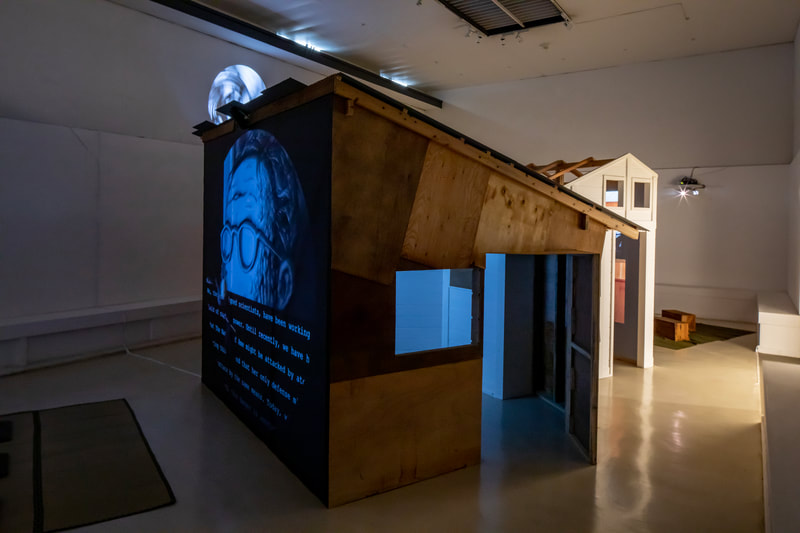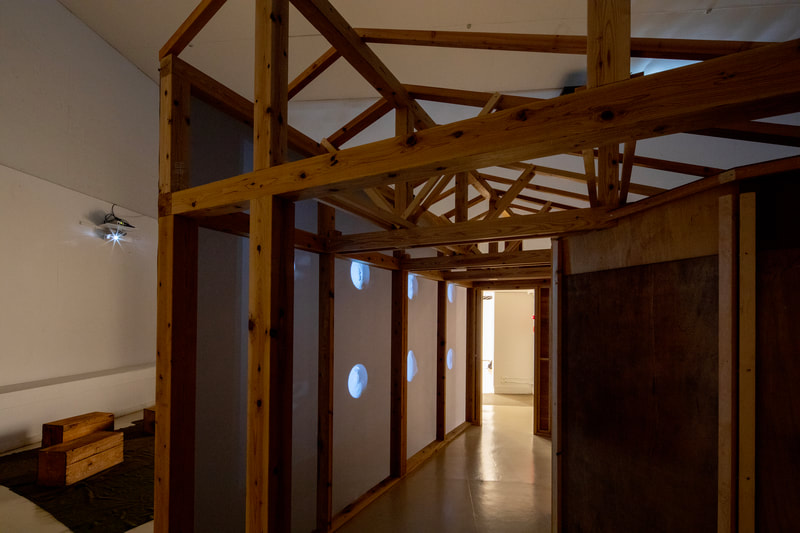ワープドライブ / WARP DRIVE
2022
Wood, PVC black front and rear projection screen, media player, projector, directional speaker, amplifier, tin plate, house paint, U.S. military wool blanket, apple box, rush mat, cushion
9’ 16” x 19’ 4” x 17’ 11" (301.5 x 590 x 545cm)
Maruki Gallery for the Hiroshima Panels
2022
Wood, PVC black front and rear projection screen, media player, projector, directional speaker, amplifier, tin plate, house paint, U.S. military wool blanket, apple box, rush mat, cushion
9’ 16” x 19’ 4” x 17’ 11" (301.5 x 590 x 545cm)
Maruki Gallery for the Hiroshima Panels
Through research, interviews, and archival studies conducted in both Japan and the US, New York-based artist Gaku Tsutaja has been creating works that focus on the historical tragedies brought about by the use of nuclear weapons. While there are major discrepancies in the stories told about nuclear weapons in these two countries, there are also similarities to be found. Tsutaja teases out these divergent accounts, creating works of art that cultivate new narratives that transcend national boundaries. As a Japanese artist living in the U.S., Tsutaja feels a personal challenge to try to understand both sides and move the discourse beyond prior perceptions and (mis)understandings conveyed by the conflicting accounts. Through deeper observations of the suffering of victims and others affected by the politics and policies surrounding nuclear weapons, Tsutaja reinterprets the historical accounts that have been repeated in the 77 years since the end of World War II and works to create new stories that make the war and events surrounding it personally relevant to the generations that have come after.
The exhibition Warp Drive at the Maruki Gallery for the Hiroshima Panels is Tsutaja’s first solo show in Japan and a homecoming for the US-based artist. The main exhibit space incorporates Tsutaja’s videos into a structure that connects a motif of two types of barracks—those that were built in the US in Japanese internment camps during World War II, and the others built in Hiroshima and Nagasaki right after the war. In the smaller gallery space, the artist’s two-dimensional works will be on view.
Tsutaja’s videos are imbued with reality. Beautiful Sky Golf Course tells the story of first-generation male Japanese immigrants, who were the first to be detained in the US on spying charges immediately following the Japanese Imperial Army’s attack on Pearl Harbor. Tsutaja completed this piece after spending six weeks at the Historical Museum at Fort Missoula, Montana, at the recreated barracks where the Japanese were interred and the courtroom where their loyalty hearings were conducted. The inspiration for the work revolved around a group of men who built their own golf course while living in the internment camp.
In ENOLA’S HEAD, Tsutaja investigates the production of nuclear weapons during the Second World War, the atomic bombings of Hiroshima and Nagasaki, the effects of radiation and its history of concealment, and the Cold War era that followed in the US. As part of her research, she visited sites related to the development of nuclear weapons — Los Alamos, Alamogordo, and Albuquerque in New Mexico; Hanford and the Spokane Indian Reservation in Washington; Wendover in Utah; and Hiroshima — and interviewed hibakusha (survivors of the atomic bombings and other radiation-affected people), historians, and various nuclear experts in Japan and the US. The characters in this video wear masks shaped like strange animals, insects, or plants, and make actions. These masks are modeled on “gigaku masks,” which were popular in Japan in the seventh and eighth centuries but died out in the Kamakura period (1185–1333). The video begins with a scene in which a bird-faced professor unearths numerous masks in a world where the Sanzu River (a mythological river souls must cross before reaching the afterlife) froze over. Digging up an extinct culture metaphorically intersects with both the artist’s use of “gigaku masks” and the hopelessness of a nuclear future.
Study with the Moon is based on an article that appeared in The Washington Post on the Enola Gay, the B-29 bomber that dropped the atomic bomb on Hiroshima, and was later left outside unprotected and exposed to the weather at Joint Base Andrews in Maryland. The bomber’s windows were broken and various parts were stolen. The video depicts a dream that the Enola Gay had at that time, while being ravaged by humans and inhabited by birds and various kinds of vermin.
Grant: Asahi Shimbun Cultural Foundation Equipment cooperation: Art Tower Mito Exhibition cooperation: Hyakujo
蔦谷楽はニューヨークを拠点とし、核の歴史的悲劇をテーマとして日米両国でのリサーチやインタビュー、またアーカイブの研究を通して、制作活動を続けてきた。核問題は日本で語られる物語とアメリカのそれでは大きく違うところもあれば、共通点もある。蔦谷はその両方に目を向け耳を傾け、国境を超えて共有されるべき物語を美術作品として構築しようと模索する。多様な社会的役割をもった核被害者や関係者たちを深く観察し、既存の意味や理解を超えようとする—それは、繰り返し語られてきた歴史物語を戦後77年経った時代にもう一度語る上で、在米日本人アーティストとしての蔦谷個人としての挑戦でもある。戦争を知らない世代が戦争を自分たちの問題として抱えるための新しい物語、それが蔦谷の作品の根幹となっている。
原爆の図丸木美術館での「ワープドライブ」は、蔦谷の日本初個展、アメリカで活動してきた作家のホームカミングである。メインの展示スペースでは、2種類のバラック—第二次世界大戦時にアメリカで建設された日系人強制収容所のバラックと戦後の広島長崎に建てられたバラック—というモチーフが接合した構造物に蔦谷の映像作品が組み込まれ、また小スペースでは平面作品が一堂に展示となる。
蔦谷の映像作品にはリアリティが込められている。「Beautiful Sky Golf Course」は、大日本帝国軍による真珠湾攻撃直後にアメリカでスパイ容疑をかけられ最初に収容された日系1世の男たちの物語。蔦谷は、日系人捕虜の収容されていたバラックや国家忠誠の有無を調べる尋問をかけられた法廷が再現保存されているモンタナ州のフォートミズーラ歴史博物館に6週間滞在し、この作品を完成させた。収容所生活の中で自分たちでゴルフコースを作ったという日系人捕虜の当時のエピソードにインスピレーションを発している。
また、第二次世界大戦時の核兵器製造、広島長崎への原爆投下、冷戦時代のアメリカ、そして現代にまで続く放射能の影響と隠蔽の経緯を作品と昇華させたのが「ENOLA’S HEAD」だ。蔦谷は核兵器の歴史に関わった場所、ニューメキシコ州のロスアラモス・アラモゴード・アルバカーキー、ワシントン州のハンフォード・スポケーンインディアン居留地、ユタ州ウェンドーバー、そして広島を現地取材し、日米の被爆者、歴史家、そしてさまざまな核の専門家たちに言質を取りながら物語を作り上げていった。この作品の中で、登場人物たちは奇妙な動物や虫、もしくは植物の形をした面をかぶり、行動を起こす。この面は日本で7、8世紀に流行しながらも鎌倉時代には絶滅した伎楽面を模しており、映像の中では、三途の川が凍りついた世界で鳥の顔をした博士が数々の面を発掘するシーンから始まっている。絶滅した文化を掘り出していくというメタファーが、伎楽面という素材の選択や核の絶望的な未来に交差してゆく。
「Study with the Moon」は、B-29エノラ・ゲイが戦後広島に原爆を投下したのちに、メリーランド州アンドリュース空軍基地に雨ざらしで屋外放置されていたというワシントン・ポストの記事をヒントに制作された。窓ガラスが割られ、部品を盗まれた爆撃機。人間に蹂躙され、鳥や様々な害獣に住みつかれたエノラ・ゲイがその間にみた夢というのがモチーフになっている。
2022年 彼らは戦争を終わらせない
悲劇の世界を駆け抜けて 未来を奪還せよ
ワープドライブへようこそ
助成:朝日新聞文化財団 機材協力:水戸芸術館 展示協力:百丈
The exhibition Warp Drive at the Maruki Gallery for the Hiroshima Panels is Tsutaja’s first solo show in Japan and a homecoming for the US-based artist. The main exhibit space incorporates Tsutaja’s videos into a structure that connects a motif of two types of barracks—those that were built in the US in Japanese internment camps during World War II, and the others built in Hiroshima and Nagasaki right after the war. In the smaller gallery space, the artist’s two-dimensional works will be on view.
Tsutaja’s videos are imbued with reality. Beautiful Sky Golf Course tells the story of first-generation male Japanese immigrants, who were the first to be detained in the US on spying charges immediately following the Japanese Imperial Army’s attack on Pearl Harbor. Tsutaja completed this piece after spending six weeks at the Historical Museum at Fort Missoula, Montana, at the recreated barracks where the Japanese were interred and the courtroom where their loyalty hearings were conducted. The inspiration for the work revolved around a group of men who built their own golf course while living in the internment camp.
In ENOLA’S HEAD, Tsutaja investigates the production of nuclear weapons during the Second World War, the atomic bombings of Hiroshima and Nagasaki, the effects of radiation and its history of concealment, and the Cold War era that followed in the US. As part of her research, she visited sites related to the development of nuclear weapons — Los Alamos, Alamogordo, and Albuquerque in New Mexico; Hanford and the Spokane Indian Reservation in Washington; Wendover in Utah; and Hiroshima — and interviewed hibakusha (survivors of the atomic bombings and other radiation-affected people), historians, and various nuclear experts in Japan and the US. The characters in this video wear masks shaped like strange animals, insects, or plants, and make actions. These masks are modeled on “gigaku masks,” which were popular in Japan in the seventh and eighth centuries but died out in the Kamakura period (1185–1333). The video begins with a scene in which a bird-faced professor unearths numerous masks in a world where the Sanzu River (a mythological river souls must cross before reaching the afterlife) froze over. Digging up an extinct culture metaphorically intersects with both the artist’s use of “gigaku masks” and the hopelessness of a nuclear future.
Study with the Moon is based on an article that appeared in The Washington Post on the Enola Gay, the B-29 bomber that dropped the atomic bomb on Hiroshima, and was later left outside unprotected and exposed to the weather at Joint Base Andrews in Maryland. The bomber’s windows were broken and various parts were stolen. The video depicts a dream that the Enola Gay had at that time, while being ravaged by humans and inhabited by birds and various kinds of vermin.
Grant: Asahi Shimbun Cultural Foundation Equipment cooperation: Art Tower Mito Exhibition cooperation: Hyakujo
蔦谷楽はニューヨークを拠点とし、核の歴史的悲劇をテーマとして日米両国でのリサーチやインタビュー、またアーカイブの研究を通して、制作活動を続けてきた。核問題は日本で語られる物語とアメリカのそれでは大きく違うところもあれば、共通点もある。蔦谷はその両方に目を向け耳を傾け、国境を超えて共有されるべき物語を美術作品として構築しようと模索する。多様な社会的役割をもった核被害者や関係者たちを深く観察し、既存の意味や理解を超えようとする—それは、繰り返し語られてきた歴史物語を戦後77年経った時代にもう一度語る上で、在米日本人アーティストとしての蔦谷個人としての挑戦でもある。戦争を知らない世代が戦争を自分たちの問題として抱えるための新しい物語、それが蔦谷の作品の根幹となっている。
原爆の図丸木美術館での「ワープドライブ」は、蔦谷の日本初個展、アメリカで活動してきた作家のホームカミングである。メインの展示スペースでは、2種類のバラック—第二次世界大戦時にアメリカで建設された日系人強制収容所のバラックと戦後の広島長崎に建てられたバラック—というモチーフが接合した構造物に蔦谷の映像作品が組み込まれ、また小スペースでは平面作品が一堂に展示となる。
蔦谷の映像作品にはリアリティが込められている。「Beautiful Sky Golf Course」は、大日本帝国軍による真珠湾攻撃直後にアメリカでスパイ容疑をかけられ最初に収容された日系1世の男たちの物語。蔦谷は、日系人捕虜の収容されていたバラックや国家忠誠の有無を調べる尋問をかけられた法廷が再現保存されているモンタナ州のフォートミズーラ歴史博物館に6週間滞在し、この作品を完成させた。収容所生活の中で自分たちでゴルフコースを作ったという日系人捕虜の当時のエピソードにインスピレーションを発している。
また、第二次世界大戦時の核兵器製造、広島長崎への原爆投下、冷戦時代のアメリカ、そして現代にまで続く放射能の影響と隠蔽の経緯を作品と昇華させたのが「ENOLA’S HEAD」だ。蔦谷は核兵器の歴史に関わった場所、ニューメキシコ州のロスアラモス・アラモゴード・アルバカーキー、ワシントン州のハンフォード・スポケーンインディアン居留地、ユタ州ウェンドーバー、そして広島を現地取材し、日米の被爆者、歴史家、そしてさまざまな核の専門家たちに言質を取りながら物語を作り上げていった。この作品の中で、登場人物たちは奇妙な動物や虫、もしくは植物の形をした面をかぶり、行動を起こす。この面は日本で7、8世紀に流行しながらも鎌倉時代には絶滅した伎楽面を模しており、映像の中では、三途の川が凍りついた世界で鳥の顔をした博士が数々の面を発掘するシーンから始まっている。絶滅した文化を掘り出していくというメタファーが、伎楽面という素材の選択や核の絶望的な未来に交差してゆく。
「Study with the Moon」は、B-29エノラ・ゲイが戦後広島に原爆を投下したのちに、メリーランド州アンドリュース空軍基地に雨ざらしで屋外放置されていたというワシントン・ポストの記事をヒントに制作された。窓ガラスが割られ、部品を盗まれた爆撃機。人間に蹂躙され、鳥や様々な害獣に住みつかれたエノラ・ゲイがその間にみた夢というのがモチーフになっている。
2022年 彼らは戦争を終わらせない
悲劇の世界を駆け抜けて 未来を奪還せよ
ワープドライブへようこそ
助成:朝日新聞文化財団 機材協力:水戸芸術館 展示協力:百丈
Photo: Ali Uchida
Press / Reviews
September 21, 2022
Robert A. Jacobs, Our Warped Drive to this Day
ロバート・A・ジェイコブス、今日も続く、私たちのワープドライブ
September 10, 2022
蔦谷楽 「ワープドライブ WARP DRIVE」(日本語)
Gaku Tsutaja: WARP DRIVE (English)
Maki Kaneko, Real Tokyo / 金子牧、Real Tokyo
核問題 グローバルな視点で 「鳥獣戯画」的手法 平易に鋭く
Fumie Iwamoto, Nikkei Shinbun / 岩本文枝、日本経済新聞
September 6, 2022
核問題 日米の視点で紡ぐ
Natsuko Koide, Saitama Shinbun / 小出奈津子、埼玉新聞
August 25, 2022
核の歴史 アートで表現 丸木美術館で蔦谷さん展覧会 福島事故に衝撃 寓話の形で本質伝える
Tokyo Shinbun / 出田阿生、東京新聞
August 24,2022
「核のシステム」を可視化 Shinano-Mainichi-Shinbun / 信濃毎日新聞
Kotaro Takami, Kyodo -Tsushin / 高見浩太郎、共同通信
August 21,2022
核の構造を可視化する Touou-Nippou / 東奥日報
Kotaro Takami, Kyodo -Tsushin / 高見浩太郎、共同通信
August 17, 2022
忘却ルーティーンに対抗 Ehime-Shinbun / 愛媛新聞
戦争全体の構造 可視化 MIyazaki-Nichinichi-Shinbun / 宮﨑日日新聞
Kotaro Takami, Kyodo -Tsushin / 高見浩太郎、共同通信
August 16, 2022
Written by Kotaro Takami, Kyodo -Tsushin / 高見浩太郎、共同通信
核の構造を可視化 Okinawa Times / 沖縄タイムス
August 15, 2022
想像絶する被爆体験 可視化 Kumamoto-Shinbun / 熊本日日新聞
核の構造を可視化する Ibaragi-Shinbun / 茨城新聞
Kotaro Takami, Kyodo -Tsushin / 高見浩太郎、共同通信
August 15, 2022
丸木美術館 来場者も戦争について考える
Television Saitama / テレビ埼玉 ニュース545
August 13, 2022
戦争を知らない世代のための「核」の物語
Chie Sumiyoshi, Figaro Japon October / 住吉智恵、フィガロジャポン 10月号
August 13, 2022
日本とアメリカをつなげ、核問題を描き続けるアーティスト。蔦谷楽インタビュー
Interview by Ryohei Nakajima, Bijututecho Youtube / 中島良平、美術手帖 Youtube
August 13, 2022
核の構造 物語として可視化 Chugoku-Shinbun / 中国新聞
核の構造を可視化する Kyoto-Shinbun / 京都新聞
核・戦争の構造可視化 Tokushima-Shinbun / 徳島新聞
可視化で想像力を拡張 Yamanashi-Nichinichi-Shinbun / 山梨日日新聞
戦争の構造 可視化する Kouchi-Shinbun / 高知新聞
非体験者にも役割ある Kitanihon-Shinbun / 北日本新聞
Kotaro Takami, Kyodo -Tsushin / 高見浩太郎、共同通信
August 12, 2022
核の構造を可視化する Kobe-Shinbun / 神戸新聞
核の構造を可視化する Nihonkai-Shinbun / 日本海新聞
核の構造を可視化する Osaka-Shinbun / 大阪日日新聞
核の構造を可視化する Sanyou-Shinbun / 山陽新聞
Kotaro Takami, Kyodo -Tsushin / 高見浩太郎、共同通信
August 11, 2022
核と戦争の歴史的悲劇に取り組む在米作家、蔦谷楽。原爆の図丸木美術館での個展「ワープドライブ」レポート
Natsuko Fukushima / 福島夏子、Tokyo Art Beat
August 9, 2022
核の記憶、複眼的視点で作品化「知らない世代」が考える入り口に
Review by Naoki Sasaki, Nishinippon Shimbun / 佐々木直樹、西日本新聞
August 9, 2022
米国で核を描く美術家
Review by Ryo Tomita, Japan Broadcasting Corporation Web Special Feature / 富田良、NHK WEB特集
August 9, 2022
日本とアメリカをつなげ、核問題を描き続けるアーティスト。蔦谷楽インタビュー
Review by Ryohei Nakajima, Bijututecho / 中島良平、美術手帖
August 6, 2022
「蔦谷楽 ワープドライブ/ WARP DRIVE」オープニングトーク
Opening Talk with Yukinori Okamura / 原爆の図丸木美術館
July 24, 2022
Japanese artist exhibits works inspired by horrors of nuclear weapons
NHK World Japan News
July 23, 2022
核の悲劇、国境越えアートに 在米日本人作家が初個展
Review by Jin Naganuma, Asahi Shinbun / 永沼仁, 朝日新聞
July 22, 2022
戦争や核兵器の問題テーマに描いた作品の企画展
Japan Broadcasting Corporation Metropolitan Area News / NHK首都圏NEWS WEB
September 21, 2022
Robert A. Jacobs, Our Warped Drive to this Day
ロバート・A・ジェイコブス、今日も続く、私たちのワープドライブ
September 10, 2022
蔦谷楽 「ワープドライブ WARP DRIVE」(日本語)
Gaku Tsutaja: WARP DRIVE (English)
Maki Kaneko, Real Tokyo / 金子牧、Real Tokyo
核問題 グローバルな視点で 「鳥獣戯画」的手法 平易に鋭く
Fumie Iwamoto, Nikkei Shinbun / 岩本文枝、日本経済新聞
September 6, 2022
核問題 日米の視点で紡ぐ
Natsuko Koide, Saitama Shinbun / 小出奈津子、埼玉新聞
August 25, 2022
核の歴史 アートで表現 丸木美術館で蔦谷さん展覧会 福島事故に衝撃 寓話の形で本質伝える
Tokyo Shinbun / 出田阿生、東京新聞
August 24,2022
「核のシステム」を可視化 Shinano-Mainichi-Shinbun / 信濃毎日新聞
Kotaro Takami, Kyodo -Tsushin / 高見浩太郎、共同通信
August 21,2022
核の構造を可視化する Touou-Nippou / 東奥日報
Kotaro Takami, Kyodo -Tsushin / 高見浩太郎、共同通信
August 17, 2022
忘却ルーティーンに対抗 Ehime-Shinbun / 愛媛新聞
戦争全体の構造 可視化 MIyazaki-Nichinichi-Shinbun / 宮﨑日日新聞
Kotaro Takami, Kyodo -Tsushin / 高見浩太郎、共同通信
August 16, 2022
Written by Kotaro Takami, Kyodo -Tsushin / 高見浩太郎、共同通信
核の構造を可視化 Okinawa Times / 沖縄タイムス
August 15, 2022
想像絶する被爆体験 可視化 Kumamoto-Shinbun / 熊本日日新聞
核の構造を可視化する Ibaragi-Shinbun / 茨城新聞
Kotaro Takami, Kyodo -Tsushin / 高見浩太郎、共同通信
August 15, 2022
丸木美術館 来場者も戦争について考える
Television Saitama / テレビ埼玉 ニュース545
August 13, 2022
戦争を知らない世代のための「核」の物語
Chie Sumiyoshi, Figaro Japon October / 住吉智恵、フィガロジャポン 10月号
August 13, 2022
日本とアメリカをつなげ、核問題を描き続けるアーティスト。蔦谷楽インタビュー
Interview by Ryohei Nakajima, Bijututecho Youtube / 中島良平、美術手帖 Youtube
August 13, 2022
核の構造 物語として可視化 Chugoku-Shinbun / 中国新聞
核の構造を可視化する Kyoto-Shinbun / 京都新聞
核・戦争の構造可視化 Tokushima-Shinbun / 徳島新聞
可視化で想像力を拡張 Yamanashi-Nichinichi-Shinbun / 山梨日日新聞
戦争の構造 可視化する Kouchi-Shinbun / 高知新聞
非体験者にも役割ある Kitanihon-Shinbun / 北日本新聞
Kotaro Takami, Kyodo -Tsushin / 高見浩太郎、共同通信
August 12, 2022
核の構造を可視化する Kobe-Shinbun / 神戸新聞
核の構造を可視化する Nihonkai-Shinbun / 日本海新聞
核の構造を可視化する Osaka-Shinbun / 大阪日日新聞
核の構造を可視化する Sanyou-Shinbun / 山陽新聞
Kotaro Takami, Kyodo -Tsushin / 高見浩太郎、共同通信
August 11, 2022
核と戦争の歴史的悲劇に取り組む在米作家、蔦谷楽。原爆の図丸木美術館での個展「ワープドライブ」レポート
Natsuko Fukushima / 福島夏子、Tokyo Art Beat
August 9, 2022
核の記憶、複眼的視点で作品化「知らない世代」が考える入り口に
Review by Naoki Sasaki, Nishinippon Shimbun / 佐々木直樹、西日本新聞
August 9, 2022
米国で核を描く美術家
Review by Ryo Tomita, Japan Broadcasting Corporation Web Special Feature / 富田良、NHK WEB特集
August 9, 2022
日本とアメリカをつなげ、核問題を描き続けるアーティスト。蔦谷楽インタビュー
Review by Ryohei Nakajima, Bijututecho / 中島良平、美術手帖
August 6, 2022
「蔦谷楽 ワープドライブ/ WARP DRIVE」オープニングトーク
Opening Talk with Yukinori Okamura / 原爆の図丸木美術館
July 24, 2022
Japanese artist exhibits works inspired by horrors of nuclear weapons
NHK World Japan News
July 23, 2022
核の悲劇、国境越えアートに 在米日本人作家が初個展
Review by Jin Naganuma, Asahi Shinbun / 永沼仁, 朝日新聞
July 22, 2022
戦争や核兵器の問題テーマに描いた作品の企画展
Japan Broadcasting Corporation Metropolitan Area News / NHK首都圏NEWS WEB
© 2015 Gaku Tsutaja




































